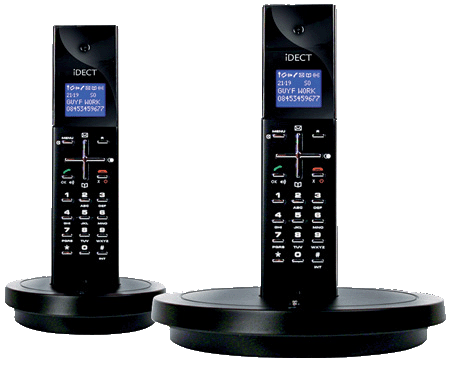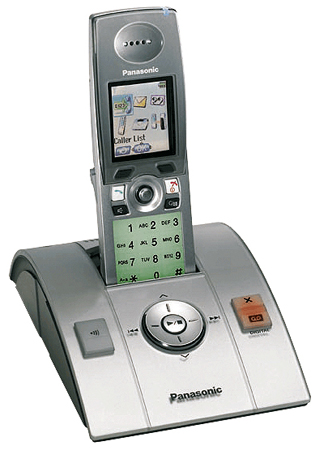This article is more than 1 year old
Hit the DECT: cordless phones on test
Ten cordless phones for your consideration
iDect X1

 The iDect X1 is one of those very welcome products that completely belies its price with a sleek and sexy design, and enough functionality to make you wonder if the spotty teen who served you in Argos had misread the price when you laid down your £30. But no, it appears that quite simply, the X1 is a bargain.
The iDect X1 is one of those very welcome products that completely belies its price with a sleek and sexy design, and enough functionality to make you wonder if the spotty teen who served you in Argos had misread the price when you laid down your £30. But no, it appears that quite simply, the X1 is a bargain.
Black as night and cut using a steel rule, we pulled it from the packaging and were immediately struck by how much smaller it was than we were expecting. Granted, the circular base station is a little too ‘dinner plate’ for our tastes, but the phone is actually rather lovely. The keypad layout is simple and clean and the big navigational bars are a breeze to use, even for the chunkiest digits.
There’s no colour screen, just a two-tone white-on-black display; no polyphonic ringtones but six monophonic alerts; and no text, alarm or fancy Bluetooth apps. But you do get a 50-contact telephone book, 20-call log and 10-number redial, speakerphone, clock, key lock, call transfer, caller ID and iSound – the surprisingly effective technology that makes call quality simply jaw-dropping considering the price.
The X1 lacks many of the features of other DECT phones in this test, but then it comes in at a far more pocket-friendly price. If you’re looking for a phone purely and simply to make calls with, in our humble opinion you won’t do much better for the price, and likely quite a few pounds more.
iDect X1
| Best for value
Cheap does not always mean nasty, as the X1 ably demonstrates |
| Price | From £30 inc VAT |
|---|---|
| More info | Argos' website |
Panasonic KX-TCD820

Panasonic’s catchily named KX-TCD820 is a quirky looking beast. While Panasonic should be commended for its unique and innovative styling efforts we’re not quite sure it’s pulled it off here, thanks to a curious mix of angles and curves, metallic silver plastic body, soft backlit green keypad, and a distinctly odd overall design. It may well appeal to the lovers of the modernist movement, but for us trad types it’s all a little too severe.
Beyond the funny looks, though, Panasonic has succeeded in crafting an intelligent and simple-to-use DECT phone that echoes well enough the functionality of the common or average mobile. Included in the package we get a decent if not class-leading 15-minute digital answerphone - incorporated into the base unit as per the norm - caller ID, SMS, EMS, 50-number call log, a punchy 1.8in, 65,536-colour screen that was one of the best we tested, intercom functionality, and, handily, an IrDA interface.
The latter enables you to copy data like the phonebook info on your mobile direct to the Panny using infrared – no need for individual inputting of numbers, which is always a pain. And with three 200-name and number phonebooks built in, the TCD820 should be able to handle all your personal and business contacts with room to spare.
The included USB port offers up even more room for updating and customising. Hook it up to a PC and you can download ringtones and images as screensavers or attach them to caller IDs for some serious mobile-style personalisation, plus you can update your contacts direct from Outlook. Call quality is faultless and with five additional handsets able to run from the base-station, versatility is the key word for the very capable KX-TCD820.
Best for home and business
Panasonic KX-TCD820
| Best for home and work
Versatile if ugly, with a booming voice - the Chris Moyles of the DECT world |
| Price | From £100 inc VAT |
|---|---|
| More info | Panasonic's UK website |

Jacob Jensen was the former head of design for the fashionistas at Bang & Olufsen, who’s BeoCom 2 is checked out elsewhere in this almighty group test. The T-6 represents Jensen’s own stylistic vision and is testimony to his love of form and function in equal measure, but where the BeoCom is all about extravagance and flair, the T-6 is measured, simple and yet still cool in a consciously retro way.
The design and build are unsurprisingly excellent, the plastic and aluminium T-6 sitting comfortably in the hand with its convex back and concave face and those long, thin keys easily accessible yet unobtrusive. There's no colour screen on the T-6, but the phone’s black/red LCD and backlit keypad are brilliantly sinister. The wall-mountable base unit also has its own LCD, simplified keypad and speakerphone so you can answer calls without having to lift the handset. Attached to the wall it looks like something far more grandiose and important than a DECT phone, but we figure that was the point.
The weight and strength of design is carried effortlessly into the T-6’s call quality, which was without fault, crystal clear and crackle free, even on the one international call we deigned a necessary test. Navigating the menu system was equally successful, but with only a 40-contact telephone book, 30-number call log, message waiting and four quick dial SOS numbers it should be easy. Because when you look at the not inconsiderable price of the T-6, its features list seems to be pretty thin in comparison to, well, every other phone in the test, including the absolute budget models. As a device for calling people and as a style talking point in your home, the T-6 is an elegant if expensive solution, but for anyone with a technology bent, it will leave you cold.
Jacob Jensen T-6
Best for style
Step back into the 1970s for a slice of style with a big price

Price
From £150 inc VAT
More info
The Comet website
| Best for style
Step back into the 1970s for a slice of style with a big price |
| Price | From £150 inc VAT |
|---|---|
| More info | The Comet website |
